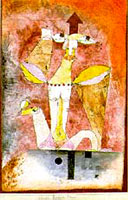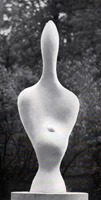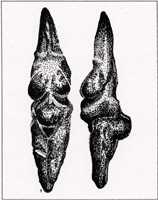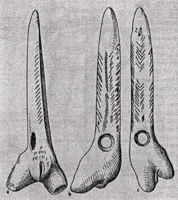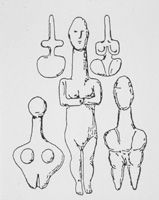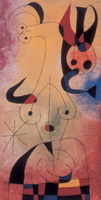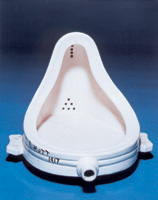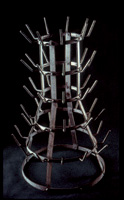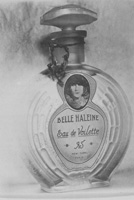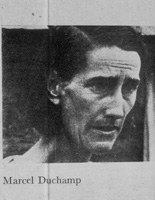Duchamp &
Androgyny: by Lanier Graham |
||||||||||||||||||||||||||||||||||||||||||||||||||||||||||||||||||||||||||||||||||
|
Barbarian's Venus by Paul Klee (1879-1940) is one of the most "barbaric" Androgyne images of the era. She is a Venus with a penis (Fig. 18). Klee was not a member of the Surrealist circle, but sometimes exhibited with them. He was associated with Kandinsky and Marc in Munich in 1911 and 1912, then took from Cubism and Orphism the concept of fluctuating planes. Klee was thought by some to be an Alchemist when he discussed the Absolute, Nothingness, and the Ground of Being. His students at the Bauhaus (only half in jest) called him "Heavenly Father." He was one of the first modern artists to explore Androgyny in tribal art.
Constantin Brancusi (1876-1957) was a very close friend of Duchamp. He studied Androgyne symbolism first in Theosophy and then in the tradition of Tibetan Buddhism. A book of Tibetan teachings was on his bedside table for many years. He and Duchamp worked together, played together, and seem to have shared many ideas about the etheric, the infinite, and the Androgynous. Such concepts were central to both artists. In 1916 Brancusi sculpted Princess X(Fig. 19). Most of the critics of the time did not like it. It was too abstract. One was particularly offended by the phallic form. Similar criticism greeted Brancusi's most famous work, "Bird in Space." Brancusi called it "Bird of the Ether" because the upward thrust is toward the etheric realm, beyond the realm of space and time, the realm that only Androgynous consciousness can reach. In spite of the phallic interpretations of many viewers, "Bird of the Ether" clearly is about not sexuality but transcendence.
Jean (Hans) Arp (1888-1966) often read Alchemical texts by Jacob Boehme and felt art should lead beyond self-expression to spirituality. He and his good friend Max Ernst made sure this attitude was part of the Dada movement and early Surrealism. Later he was deeply inspired by Brancusi's fluid style. He carved a number of beautiful Androgynes. His Demeter makes use of the traditional Iron Age symbolism of the Goddess-God with one breast (Fig. 20). For his Idol(Fig. 21) Arp seems to have gone farther back in time for his iconography, back to the Androgyne symbolism of the Stone Age and Bronze Age, when it was not uncommon for idols to have an abstract female body and a tall abstract phallic neck/head (Figs. 22A &22B).
Joan Miró (1893-1983) spoke of wanting his art to express the unity of the finite and the infinite. He was particularly interested in Stone Age art in his later years and used the ancient phallic neck/head symbolism of the Stone Age in his Androgynous painting "Dawn Perfumed by a Shower of Gold." The lower part is quite female, while the upper part is quite male (Fig. 23).
Nudes, Rroses, etc.
As we have seen, Duchamp was not the only artist of the Dada-Surrealist era interested in Androgyny. The image of the Androgyne was very important to many of the major artists in this circle. They talked about Androgynes in Alchemy, as well as in esoteric Hinduism and esoteric Buddhism wherein the Androgyne also is a primal symbol for Enlightened consciousness. They knew what the Androgyne is, and considered it the ideal condition of human awareness. This is not to say that all these artists actually attained Androgyny, but only to indicate that Androgyny was, to a large extent, their common goal. Even though many Surrealist artists rendered images of the Androgynes and were working towards the condition of Androgyny within themselves, Duchamp devoted more years of his life to articulating images of the Androgyne than any other major artist of the twentieth century, with the possible exception of his good friend Max Ernst. More has been written about Duchamp's Androgyne images than about anyone else's modern Androgyne images, but the focus of most of the literature has been on gender issues not metaphysics. This book is about metaphysics. Some would begin the list of Duchamp's Androgyne images with Nude Descending a Staircase, No. 2 of 1912, his most famous painting. While most people simply assume the nude is female, a close examination reveals there is a gender question. Is the figure male or female? "Nu" in French can mean male or female, and the visual evidence is not conclusive. This very ambiguity is interpreted by some as being Androgynous, especially in light of the unusual way Duchamp responded to the gender question in a 1916 interview: "Is it a woman? No. Is it a man? No. To tell you the truth, I have never thought which it is. Why should I think about it?" (21) Some think the slightly later Bride also is an Androgyne image, but that depends largely on how one interprets The Large Glass. Others would begin the list with L.H.O.O.Q. of 1919 where Duchamp added a mustache and beard to Leonardo's "Mona Lisa," having heard that Leonardo was homosexual. This modified ready-made clearly was intended as a joke, but it also clearly was a deliberate form of Androgyne imagery.
Some would begin the Androgyne list two years earlier with Fountain - the signed ready-made urinal of 1917(Fig. 24) . To declare this plumbing fixture a work of art certainly was a striking challenge to the aesthetic sensibilities of the time, and for many still is a challenge. Even though it is now accepted as a work of art, what might be Androgynous about it? Several people interested in religion (as Duchamp himself was not) looked at this image in 1917 as an abstract form of Buddha or the Virgin Mary. Male Buddha/Holy Mother? Perhaps the combination of those two holy images would be an Androgyne? It would echo the ancient idea of Androgyny if the combination of Divine Mother/Divine Son were deliberate, but there's no evidence that this was the case in Duchamp's mind. Some (with a Freudian psychology) see this open receptacle as a female space into which a male enters. This may have been slyly sexual symbolism on Duchamp's part, but the symbolism of common copulation is not the iconography of Androgyny. The same goes for the ready-made Bottle Dryer of 1914 (Fig. 25). Some see the elements that hold the drying bottles as male and the implied bottles as female. That symbolism may be humorously sexual, but it is not inherently Androgynous. Not
so with the gender-bending character Duchamp created as a female alter
ego in 1920: Rrose Sélavy. After his Mona Lisa of 1919,
we find a string of Androgyne images in Duchamp's work, some humorous,
some serious. He worked on these Androgyne images every decade for the
rest of his life. Rrose even "signed" a number of major objects,
as well as most of his literary works over the next twenty years. Was
Duchamp homosexual? No. Was he bisexual? No. Neither was he homophobic.
He had any number of homosexual and bisexual friends. Did he dress in
drag regularly? No - only when making a work of art (Figs.
26, 27, 28). This
series of male-female images from 1919 to 1942 certainly was intended
to be amusing, but they also publicly propagated the idea of Androgyny
as "food for thought." He did not stop thinking about the
Androgyne. In 1946 Duchamp secretly began work on the monumental Androgyne
image that would occupy him for most of the rest of his life.
"...for the adept to achieve higher consciousness means, in the first place, acquiring 'golden understanding' (aurea apprehensio) of his own microcosm and of the macrocosm in which it fits. It is in the course of his pursuit of the Philosopher's Stone that he acquires this new awareness. Thus the quest is more important than its reward; as a matter of fact, the quest is the reward. Alchemy is nothing other than an instrument of knowledge - of the total knowledge that aims to open the way toward total liberation. ... Individuation, in the alchemical sense, entails abolishing the conflicting male-female duality within the integrated personality... . Eliade has pointed out that 'to be no longer conditioned by a pair of opposites results is absolute freedom'." (22) Some, including Schwarz, Jack Burnham, Ulf Linde, John F. Moffitt, and others, have worked hard to have us see Duchamp as an Alchemist. Duchamp, however, offered little support for this belief. Indeed, he made efforts to deny it. When I met Duchamp in 1967 I had been studying the symbolism of Alchemy for a number of years and suspected that he might be an actual Alchemist. While it is true that the Androgyne is the goal of Alchemy, it is possible to have a particular interest in the Androgyne without being an Alchemist. I did not understand this at the time. Duchamp illuminated me. Here is how one of our conversations went:
Notes
Figs.
24-28
|
||||||||||||||||||||||||||||||||||||||||||||||||||||||||||||||||||||||||||||||||||
